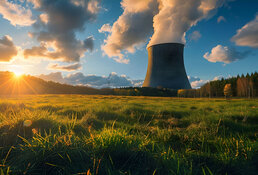Thomas Drolet: My speeches at the January Cambridge House International Resources Conference and the March Murdock Capital Partners Conference sessions highlighted two major aspects of the need to reorient U.S. energy policy. The first and foremost is to prioritize baseload power (available around the clock) in the electrical supply system. The U.S. currently has 104 reactors, which only represent 10% of the installed base, but they generate 20% of the actual electricity consumed. All industrialized manufacturing-intensive economies like the U.S., Canada, the EU and Japan require constantly available baseload power. The only other electricity generating methods that can meet that need are hydroelectricity and geothermal power. All other sources are employed as part-time or peaking power sources because they are not built for full-time operational use, nor are their fuel supplies always available.
Secondly, I highlighted the onset of the shale gas technology revolution, meaning fracking and horizontal drilling, as well as the need for the industry to be transparent in disclosing and managing fracking fluids and the copious quantities of water the process requires. I believe natural gas from shale formations will be the major growth fuel for electricity and some forms of transportation. Natural gas transmission and distribution systems need to be massively extended to accommodate this burgeoning fuel supply.
I also participated in a panel at the Murdock Conference on the major new finds of natural gas and oil off the northwestern and southeastern coastal zones of Africa. This is a very progressive, transformational opportunity for the continent.
TER: How does nuclear energy fit into your policy vision? Uranium provides tremendous baseload power and it is also one of the more efficient means of power generation.
TD: That is correct. Efficiency can be measured in several ways, be it in the small amount of uranium fuel and the lack of CO2 emissions or the increasing thermal cycle efficiencies of newer plant designs. Output power is transmitted at very high voltages, so line losses are quite low as long as power is not sent over thousands of miles. All around, nuclear power is a very efficient, productive and constant power system. However, nuclear power entails very high initial capital costs to install the systems. Many very clever engineers are working on reducing those capital costs in the next generation of reactors that are now being commissioned in China, India and many other nations. The operating costs for nuclear reactors are, however, incredibly low.
TER: We are just past the one-year mark of the Fukushima nuclear disaster in Japan. Has this catastrophe had any positive influence on the industry through resulting upgrades to nuclear reactors and better safety measures?
TD: It is certainly a real wake-up call to the industry. I was part of a small Canadian group that was the first foreign group to go to Russia after Chernobyl in 1986. I bring that up only to paint a picture of the difference between Chernobyl and what it did to the industry versus this recent event in Japan. Seeing that catastrophic failure in Chernobyl and its affect on the development of the industry was a very sobering experience.
My experience with Fukushima in advising some of its institutions suggests that this too is going to have a short- to middle-term effect in specific countries. Japan has 54 reactors installed that were generating approximately 30% of its power. Now, one year after Fukushima, only two reactors are operational. Industries are importing massive amounts of diesel power generation capability. Japan is going to have to make a major decision in the next few months to either bring back some of those shut-down nuclear stations, which are undergoing safety reviews, or be in major trouble again this summer, a peak period from a power supply point of view. Thank goodness that Japan is able to help itself, as it is the most advanced country in the world in implementing energy-efficient technologies and conservation techniques.
TER: Germany decided to shut down its nuclear reactors over the next decade and similar decisions were made in other European countries. Can we expect other governments to follow suit?
TD: I find it somewhat ironic that Germany, as it looks ahead another decade to figure out how to replace some 23% of its power facilities, is talking about importing nuclear power from France and the UK. There are many combined cycle gas turbine manufacturers and energy efficiency and conservation techniques that can offset those shortages, but that would require Germany and Switzerland to depend on shale gas drilling from Russia.
TER: Germany and Switzerland aside, the World Nuclear Association says there will be 650 nuclear reactors operating by 2032. There are currently just under 400 nuclear reactors in use. Which countries are planning on building the bulk of those reactors?
TD: China is currently building 13 reactors with a further 18 under design and site development. Over the subsequent 5-, 10- and 20-year terms, China will build upwards of another 80. Second on the list is India, which has six reactors and is currently planning 20 more. Next would be South Korea. Saudi Arabia and the United Arab Emirates have announced plans to build about 14 nuclear reactors over the next decade. There are other nations planning to develop their nuclear power programs, too. The U.S. itself has just commissioned two in the southeast of the country with Southern Power and Georgia Power. Those plants will employ Westinghouse-Toshiba AP1000s.
TER: Three Mile Island ocurred in 1978, Chernobyl in 1986 and Fukushima in 2011. Can nuclear power sustain those types of hits to its reputation and still see a 50% growth rate in reactor buildout through 2032?
TD: Absolutely not. Nuclear power cannot remain a viable generation technique if these accidents keep occurring at that frequency. The industry needs to ensure that next-generation reactors are more inherently safe in the event of a breakdown of any sort. New reactor systems are available to address these very real concerns.
TER: Why should the public believe that new reactors are safer and more resilient than current models?
TD: It is going to take a lot of discussion by the industry to prove that to the public. They must come out of their shells and openly debate the issues in a transparent fashion. It's up to them to convince the public.
TER: In 2010, about 118 million pounds (Mlbs) of uranium were produced, while 190 Mlbs were consumed. The difference was supplied by uranium from recycled nuclear weapons, mostly from Russia, but that program ends in 2013. Are you expecting a resulting price spike?
TD: With Putin coming back into power, there is a slight chance that program will be extended or a similar program will be developed. I rate the chance of that at 20%. President Obama has stated that he wants to reduce the number of nuclear weapons around the world over time to much lower levels. So there is also the potential for the U.S. weapons program to be further reduced. However, if the "Megatons to Megawatts" program does end in 2013, then many nations that are big on nuclear power and nuclear weapons and that have strategic uranium reserves, such as the U.S., Russia, France, England and China, could meet uranium shortfalls in a pinch.
TER: There is a strong possibility that most of the supply deficit will come from mined sources. Which jurisdictions will primarily meet the need?
TD: I want to highlight closer-to-home sources. Most of the supply for our reactors in North America should come first and foremost from the Athabasca Basin in Canada. The highest-grade uranium in the world today is in Saskatchewan, Alberta and northeastern Manitoba. Next, we have Wyoming in the U.S.—probably the nation's most prolific future source of uranium. Then would come Utah, Colorado, Arizona and New Mexico, namely the Lisbon Valley and Uravan mineral belt.
TER: Should retail investors take equity positions in companies operating in these specific areas now or should they wait until the uranium price starts its run up as is expected?
TD: There is a critical time between the market price action of uranium and these uranium development companies' stocks. Personally, I would build an investment regime as the price builds up. It is always a better investment strategy in these uncertain times to hedge your risk and invest as the price goes up, which I certainly believe it will over the next several years.
TER: Are there some promising projects in the Athabasca Basin in Wyoming and the southwestern U.S.?
TD: In Wyoming, Strathmore Minerals Corp. (STM:TSX; STHJF:OTCQX) is a well managed company with a strong geologist team that already has a partnership with KEPCO. KEPCO is the operator of a fleet of some 20 reactors in South Korea, supplying 35% of the country's electricity. The company is also a reactor supplier to international markets. KEPCO has a real and pressing need for uranium and is starting to tie up partnerships in various uranium basins. KEPCO is heavily invested in the Athabasca as well as in Strathmore Minerals. I believe Strathmore has now finished putting together the private placement of approximately $8 million worth of investment in the Gas Hills project in Wyoming.
TER: Strathmore also has the Roca Honda project in New Mexico.
TD: That is another excellent project.
TER: Plus it has Sumitomo, a Japanese company, as a partner there. With partners like that, Strathmore is not going to have to go to the market as much to do financing, correct?
TD: Exactly. Diversification for Strathmore is an excellent strategy. And another company, Fission Energy Corp. (FIS:TSX.V; FSSIF:OTCQX) has an excellent land package up in the central core of the Athabasca basin.
TER: Fission also has a joint venture with KEPCO and a consortium of Korean companies led by KEPCO, right?
TD: That is correct. KEPCO has joined up with Fission Energy and its strong management team. Certainly Fission Energy is getting along on its drill program much faster and further than many other juniors. Some of the results it is coming up with are of quite high-grade quality. The third one is Athabasca Uranium Inc. (UAX:TSX.V; ATURF:OTCQX), a company with an excellent land package and management team.
Athabasca Uranium's land package is surrounded by many of the majors—the Rio Tinto's, the Cameco's and the Denison's of this world. Athabasca Uranium is on a very good geological trend with many other discoveries and deposits and milling operations, all in the same approximate area. Athabasca Uranium is where Hathor was back in 2008 in terms of its drilling program. It just announced a new partnership with an Alberta-based geological drilling company. Its strengths include its geology team with Dr. Peter Born and its tie with a world class University of Saskatchewan uranium team. Athabasca Uranium does indeed have some very good uranium supply prospects for the future. It will obviously be on the hunt for a partnership as well, probably with Chinese, Korean or French companies and perhaps with some of the majors I have already mentioned.
TER: The company hired Dr. Zoltan Hajnal, a seismic exploration expert who has worked with Hathor Exploration, which was bought by Rio Tinto. What did you think of that move?
TD: Yes, that is a great example of the solid business strategy being implemented by the Athabasca Uranium management team of Gil Schneider, Barry Lee and Todd Hanas. Dr. Zoltan brings the same technological capability that he brought to Hathor to Athabasca Uranium.
TER: Going back to Fission Energy: On its Waterbury Lake project, there is some thought that there might be the extension of Hathor's mineralized zone. Do you know anything about that?
TD: I have certainly read up on it. Given the proximity in terms of distance, Fission is right on the border and part of the same rock mass and reservoir mineralization zone. It could have some of the same potential as Hathor in these areas.
TER: What does the next decade look like for coal-based power generation?
TD: Well, we have to talk on a country-specific basis in the area of coal. Let me make one overall comment first. There is an understanding—at least in the public—that climate change is in a major part driven by CO2 emissions. Coal-fired power stations and cars are the major contributing sources. In the United States and Canada, coal-fired power's day is waning gradually. Some old plants are being shut down. But 45% of the electricity consumed in the United States last year came from coal-fired power. If we do not want to shut the country down, I see an obvious continuing future for coal-fired power plants, but I do not see an increase in coal-fired power capacity potential; I see a gradual decline. Therefore, the thermal coal industry in the U.S. will need to find export markets for growth. It still has the baseload supply the United States needs covered, but its future strategic objective should be to look for markets elsewhere. In Canada, roughly the same trend is going on. The Ontario government has a program to shut down all of its coal-fired power plants by 2014. As misguided as that very short-term goal may be, in my opinion, that is the political reality. So, when you look at coal supply in Canada, I can see companies turning their attention back to supplying the now-prodigious needs for high-quality coal that will obviously be demanded from Japan, Korea and China.
Let me now give you the other side of the coin. In Asia, the number of coal-fired power plants still being built in China is mind boggling. They are using better technology and nearly all of that technology is coming from Canada, the U.S. and Europe. However, coal supplies have to come from as near to China as possible, so look to Australia, Mongolia and China, itself, as the major coal suppliers to China. India has a well developed coal-fired building program as well. Its mines cannot keep up with its coal supply needs, so it will be importing from Australia, Indonesia and possibly Canada and the U.S. Also, look at what's going on in Europe today. If we believe what economists are saying, Europe is going into a recession for some period of time. The demand for power in Europe is going down and, therefore, the demand for thermal coal in Europe is not growing. It will be shrinking slightly in the near to middle term.
TER: What does that mean for coal juniors in the near-term?
TD: Those North American coal juniors who are export-oriented are a good bet. And those juniors who own deposits of thermal coal in and near the growth areas, like China or India, are a good bet. But the juniors focusing solely on supplying the North American market may or may not be a good bet.
TER: Are any coal companies on your radar?
TD: Coalspur Mines Ltd. (CPT:TSX; CPL:ASX) is an example of a Canadian junior with exceptional holdings of land and coal. It has a good management team and a focus on developing those thermal coal deposits. There is also Prophecy Coal Corp. (PCY:TSX; PRPCF:OTCQX; 1P2:FSE), which boasts a very good eclectic collection of international management competence. The company holds very large thermal coal deposits in Mongolia and is well positioned to be able to develop exports to China as well.
TER: Any parting thoughts for us on the energy space?
TD: Fukushima was a major event for nuclear power, even more than Chernobyl. Fukushima happened within one of the most densely populated land masses on earth and, secondly, it happened in an industrialized nation known for its competence in engineering, construction and operations. In addition, the public was already jaundiced and skeptical about nuclear power because of historical events. This combination makes Fukushima a more noteworthy event, and therefore there is a need for the nuclear industry and its regulators to pause and really think through the nuclear power systems they are building for the future. We need to ensure next-generation reactors are not built in locations where nature's events, like tsunamis and earthquakes, are likely. That said, I would hope the public will give the industry a chance to prove itself through more reasonably priced electricity and demonstratively safe baseload electricity. It's up to the collective nuclear industry to prove its future worth.
TER: Thanks so much.
TD: You are very welcome.
Thomas Drolet is the principal of Drolet & Associates Energy Services Inc. He has had a 42-year career in many phases of energy—nuclear, coal, natural gas, geothermal and distributed generation, with expertise in commercial aspects, research and development, engineering, operations and consulting. He earned a bachelor's degree in chemical engineering from Royal Military College of Canada, a master's of science degree in nuclear technology/chemical engineering and a DIC from Imperial College, University of London, England. He spent 26 years with North America's largest nuclear utility, Ontario Hydro, in various nuclear engineering, research and operations functions.
Want to read more exclusive Energy Report interviews like this? Sign up for our free e-newsletter, and you'll learn when new articles have been published. To see a list of recent interviews with industry analysts and commentators, visit our Exclusive Interviews page.
DISCLOSURE:
1) Brian Sylvester of The Energy Report conducted this interview. He personally and/or his family own shares of the following companies mentioned in this interview: None.
2) The following companies mentioned in the interview are sponsors of The Energy Report: Fission Energy Corp., Athabasca Uranium Inc., Prophecy Coal Corp., Coalspur Mines Ltd. and Strathmore Minerals Corp. Streetwise does not accept stock in exchange for services.
3) Tom Drolet: I personally and/or my family own shares of the following companies mentioned in this interview: None. I personally and/or my family am paid a small retainer by the following companies mentioned in this interview: Athabasca Uranium Inc. I was not paid by Streetwise for participating in this story.








































